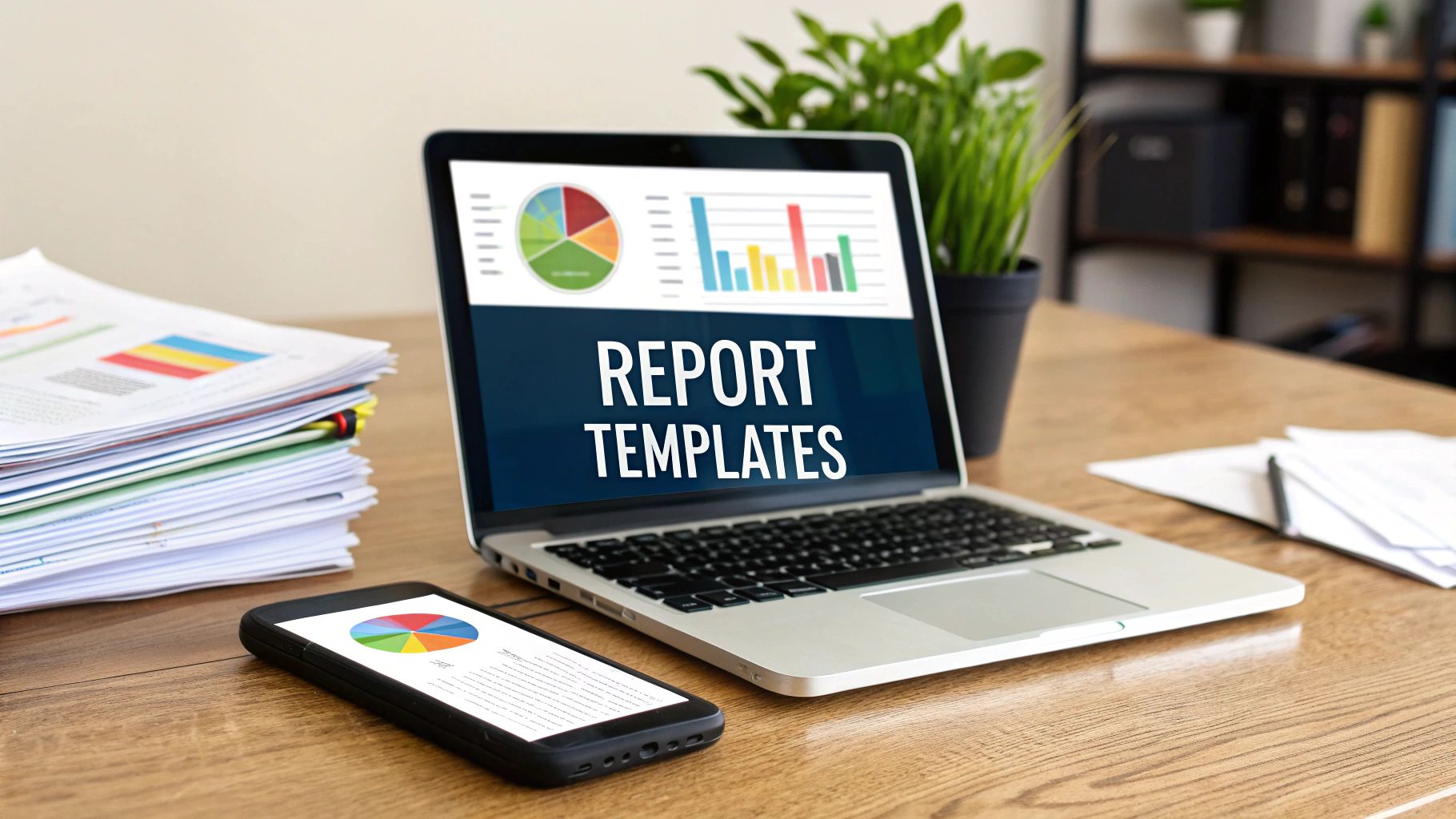Writing a progress report can feel like a chore, a box-ticking exercise that pulls you away from the actual work. But what if it could be a powerful tool for communication, alignment, and success? A well-crafted progress report doesn't just list tasks; it demonstrates value, identifies risks, and keeps stakeholders confidently informed. It transforms a simple update into a strategic asset that builds trust and highlights your team's contributions, whether you're managing a complex construction project, a door-to-door sales team, or a critical software development sprint.
This guide moves beyond generic templates. We will dissect a diverse collection of progress report sample excerpts, each tailored for different professional contexts, from project management to academic research. For every example, we will provide a detailed strategic breakdown, offering actionable takeaways you can immediately apply. You will learn not only what to include but why it matters, enabling you to customise your reports for maximum impact. Forget staring at a blank page. Here, you'll find the structure, language, and strategic insights needed to create reports that get read, understood, and valued, ensuring everyone from your sales manager to your key client sees the clear path of progress.
1. The Project Management Progress Report: Your 360-Degree Project Health Check
The project management progress report is the cornerstone of effective project oversight. Unlike a simple task list, it provides a comprehensive, 360-degree view of a project's health, aligning stakeholders, managing expectations, and proactively identifying risks before they derail your timeline. It's a structured communication tool that synthesises data from various project areas into a digestible format for executives, clients, and team members.
This type of report is essential for complex projects with multiple moving parts, dependencies, and stakeholders. It’s particularly valuable for field sales managers overseeing regional campaigns, solar installation project coordinators, and telecommunication companies managing network rollouts. It moves beyond "what we did" to analyse "where we are, where we're going, and what might stop us."
Sample Excerpt: Weekly Project Status
Project Name: Q3 GTA Fibre Network Expansion Reporting Period: October 9 - October 15, 2023 Project Manager: Sarah Chen Overall Status: On Watch
Key Accomplishments This Week:
- Completed initial site surveys for all 15 Phase 1 residential blocks.
- Finalised permitting applications with the municipal office; awaiting approval.
- Onboarded and trained the new East-End installation subcontractor.
Upcoming Milestones (Next 2 Weeks):
- Receive municipal permit approvals (Target: Oct 20).
- Begin initial trenching work in the designated North Zone (Target: Oct 23).
- Finalise material procurement with vendors (Target: Oct 27).
Risks & Issues:
- RISK: Potential delay in permit approval due to municipal backlog. Mitigation: Daily follow-up calls scheduled with our city contact.
- ISSUE: Key material (fibre optic cable) delivery is delayed by 3 days. Impact: This will not affect the start of trenching but may create a bottleneck in week 3.
Budget Overview:
- Spent to Date: $115,200 (23%)
- Total Budget: $500,000
- Forecast: Currently on budget.
Strategic Breakdown
This progress report sample excels because of its clarity and forward-looking perspective. The colour-coded status immediately signals the project's condition, saving senior leaders time. It doesn't just list completed tasks; it connects them to upcoming milestones, creating a clear narrative of the project's flow.
Key Tactic: The clear separation of "Risks" (potential future problems) and "Issues" (existing problems) is crucial. This allows for proactive management of possibilities and reactive solutions for current realities, preventing stakeholder confusion.
Actionable Takeaways
- Implement a RAG Status System: Use Red, Amber (On Watch), Green (RAG) to provide an at-a-glance summary. This is a highly effective visual cue for busy executives.
- Quantify Everything Possible: Instead of "site surveys done," specify "15 Phase 1 residential blocks." Instead of "on budget," show "Spent 115,200 (23%) of 500,000."
- Focus on Mitigation: For every risk identified, you must propose a mitigation strategy. This demonstrates proactive problem-solving and builds confidence that the project is in capable hands. A report without solutions is just a list of complaints.
2. The Academic Research Progress Report: Charting the Course of Discovery
The academic research progress report is a formal, methodical document that serves as the lifeblood of scientific inquiry and scholarly pursuits. It is the primary tool used by researchers, PhD candidates, and grant recipients to communicate their advancements to funding bodies like the NIH or NSF, university committees, and institutional review boards. Far more than a simple lab notebook entry, it justifies continued support and resources by meticulously documenting progress against stated research objectives.
This report is indispensable for long-term studies where milestones are measured in months or years, not days. It's critical for a medical researcher applying for the next phase of a grant, a PhD student demonstrating dissertation viability, or an engineering team at a university reporting on industry-sponsored research. The focus is on rigour, reproducibility, and the honest appraisal of findings, including unexpected ones.

Sample Excerpt: Annual Grant Progress Report
Project Title: The Role of GLP-1 Agonists in Neuroprotective Pathways Grant Number: CIHR 45B-112 Reporting Period: Year 1 (September 1, 2022 - August 31, 2023) Principal Investigator: Dr. Eleanor Vance Overall Status: On Track
Progress Towards Aims:
- Aim 1: Establish In-Vitro Model. Completed. Successfully cultured and validated primary cortical neuron cell lines. Cell viability assays show 98% purity.
- Aim 2: Assess Neuroprotective Effects. 75% complete. Dose-response curves for 3 of 4 planned agonists have been generated. Initial data indicates a significant (p < 0.05) reduction in apoptotic markers.
- Aim 3: Identify Pathway Mechanisms. Not started. On schedule to begin in Q4 2023.
Key Findings & Data:
- Unexpected finding: Agonist B demonstrated significant anti-inflammatory properties in addition to neuroprotection, a previously undocumented effect.
- All raw data, protocols, and statistical analyses have been logged in the shared institutional repository.
Deviations & Challenges:
- Deviation: Substituted original cell medium with a new formulation (BioGro-2) due to a supply chain issue with the original vendor. Validation tests confirmed no impact on experimental outcomes.
- Challenge: Initial Western blot results for Aim 2 showed high variability. Solution: Refined protein extraction protocol and implemented stricter temperature controls, which has resolved the issue.
Personnel Update:
- Dr. L. Khan (Postdoctoral Fellow) joined the project in January 2023.
Strategic Breakdown
This progress report sample demonstrates its value through its formal structure and unwavering focus on the original research aims. The status of each objective is clearly articulated, providing a direct link between the work performed and the goals outlined in the grant proposal. It builds credibility by not only highlighting successes but also transparently addressing challenges and the solutions implemented.
Key Tactic: Highlighting unexpected findings is a powerful strategy in academic reporting. It shows deep engagement with the data and can open new avenues for future research, which is highly valued by funding bodies.
Actionable Takeaways
- Align with Original Aims: Structure your entire report around the specific aims or objectives stated in your initial proposal. This is the first thing reviewers will look for.
- Reference Your Data: Don't just state a finding; mention the data that supports it (e.g., "p < 0.05," "98% purity") and where it can be found. This adds a layer of verifiable credibility.
- Document Deviations Logically: If you had to deviate from your plan, explain why it happened, what you did to validate the new approach, and why it doesn't compromise the research integrity. This turns a potential problem into a demonstration of sound scientific judgment.
3. The Employee Performance Progress Report: Charting Individual Growth and Impact
The employee performance progress report is a critical human resources tool that moves beyond annual reviews to provide a continuous, evidence-based record of an individual's journey. It systematically tracks goal achievement, skill development, and overall contribution, forming the bedrock for meaningful performance conversations, career pathing, and fair compensation decisions. This is not just a report card; it's a dynamic roadmap for professional growth.

This type of report is indispensable for organisations committed to developing talent from within, such as scaling sales teams, field marketing agencies, and home service companies. It provides managers with the data needed to coach effectively, recognise high-performers, and support those who are struggling. It transforms performance management from a once-a-year event into an ongoing, collaborative dialogue focused on development.
Sample Excerpt: Quarterly Performance Check-In
Employee Name: David Miller Role: Senior Field Sales Representative Review Period: July 1 - September 30, 2023 Manager: Brenda Davis Overall Progress: Exceeding Expectations
Key Achievements vs. Goals:
- Goal: Achieve 150,000 in new sales revenue. **Result:** Achieved 172,500 (115% of target), driven by securing two major enterprise accounts.
- Goal: Increase lead conversion rate by 5%. Result: Increased conversion rate by 7% through improved qualification techniques. For teams looking to enhance this metric, understanding sales efficiency through better lead routing can be a game-changer.
- Goal: Mentor one junior sales representative. Result: Actively mentored Alex Ray, who closed his first solo deal in September.
Areas for Development:
- Enhance strategic planning for long-cycle sales deals.
- Develop advanced presentation skills for C-suite-level pitches.
Employee Self-Assessment Summary:
- "I feel confident in my closing abilities but want to focus next quarter on building a more robust pipeline for Q1 2024. I would appreciate coaching on territory-mapping strategies."
Manager's Comments:
- David has shown exceptional initiative and consistently surpasses his targets. His mentorship has had a visible positive impact on the team. We will arrange for him to attend the Advanced Sales Strategy workshop next month.
Strategic Breakdown
This progress report sample is powerful because it's a two-way conversation, not a top-down judgment. It directly compares results against pre-defined goals, making the assessment objective and data-driven. The inclusion of the employee's self-assessment gives them a voice, fostering ownership over their own development and career trajectory.
Key Tactic: The "Areas for Development" section is framed constructively. It's not about weaknesses; it's about future growth. This shifts the entire tone of performance management from punitive to developmental, which is crucial for retaining top talent.
Actionable Takeaways
- Establish SMART Goals: Begin every review period by collaboratively setting Specific, Measurable, Achievable, Relevant, and Time-bound goals. This creates a clear benchmark for success.
- Integrate Self-Assessment: Require employees to reflect on their own performance before the review meeting. This prepares them for a more productive, forward-looking conversation.
- Balance Quantitative and Qualitative: Combine hard metrics (sales numbers, conversion rates) with qualitative observations (mentorship, team collaboration). This provides a holistic view of the employee's contribution, recognising that not all value can be captured in a spreadsheet.
4. The Marketing Campaign Progress Report: Your ROI Command Centre
The marketing campaign progress report is the lifeblood of data-driven marketing, translating raw metrics into strategic intelligence. It moves beyond vanity numbers like "likes" to measure what truly matters: reach, engagement, conversions, and, most importantly, return on investment (ROI). This report is a crucial tool for analysing campaign performance across multiple channels, from digital ads to event marketing, allowing teams to optimize in real-time and justify budget allocation.

This type of report is indispensable for field marketing agencies, home service companies running local promotions, and energy providers promoting new solar programs. It provides a clear, quantifiable link between marketing activities and sales outcomes, which is vital for any team needing to prove its value. Without it, marketing is just guesswork; with it, every dollar spent becomes a calculated investment.
Sample Excerpt: Monthly Digital Campaign Review
Campaign Name: "Autumn Solar Savings" Initiative Reporting Period: September 1 - September 30, 2023 Marketing Lead: David Miller Overall Status: Performing Above Target
Key Performance Indicators (KPIs) vs. Target:
- Impressions: 1,250,000 (+15% vs. target of 1,080,000)
- Lead Form Submissions: 485 (+21% vs. target of 400)
- Cost Per Lead (CPL): 45.30 (-10% vs. target of 50)
- Sales-Qualified Leads (SQLs): 75 (+7% vs. target of 70)
Channel Performance Highlights:
- Facebook Ads: Highest volume of leads (210), but highest CPL ($55).
- Google Search Ads: Best lead quality; generated 40% of all SQLs with a CPL of $42.
- Community Event Booth: Lowest CPL ($35) and high engagement, generated 95 leads. Explore how to leverage event marketing for future campaigns.
Insights & Recommendations:
- Insight: While Facebook drives volume, Google Search delivers higher-intent leads that convert to SQLs more efficiently.
- Recommendation: Reallocate 15% of the Facebook Ads budget to Google Search Ads for the next month to maximize SQL generation.
Budget Overview:
- Spent This Period: $21,960 (98%)
- Monthly Budget: $22,500
- Forecast: On budget, with strong ROI.
